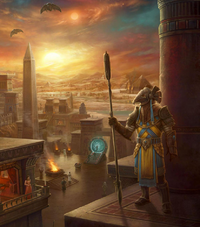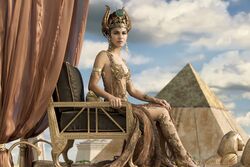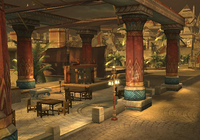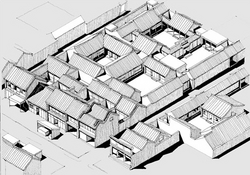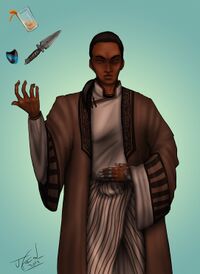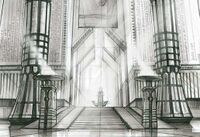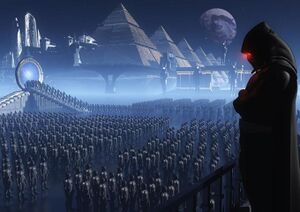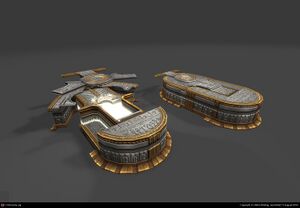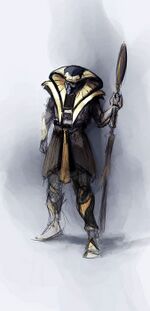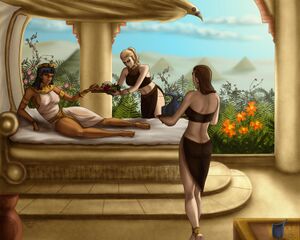Lord Atum
The Hundred Worlds of Lord Atum | |
|---|---|
| Motto: "The Claw of Atum ends the Strife of the Worlds" | |
| Anthem: "The Hymn of Atum" | |
 | |
| Capital | The Mount, Mnewer |
| Official languages | Goa'uld, English, Ancient Egyptian, |
| Ethnic groups (By Species - 2013) | Goa'uld (0.1%), Jaffa (5.3%), Human (73.4%), Others |
| Religion | Atumism |
| Demonym(s) | Atumites, Goa'uld, Destroyers, Ettins |
| Government | Tyranny |
• God | Atum |
| Refounding From Third Goa'uld Dynasty | |
• Battle of Ammut | 49th Akhet |
| Area | |
• Total | 5,429,300,000,000 km2 (2.0963×1012 sq mi) |
| Population | |
• Estimate | Uncertain |
| GDP (PPP) | estimate |
• Total | $164 trillion |
• Per capita | $9,266 |
| Gini (2013) | 75 very high |
| HDI (Breheimian NWI 2012) | 0.337 low |
| Currency | Sheshta (N/A) |
| Time zone | Annu Standard Time and Calendars (Record-keeping) |
Insular and isolationist, the Hundred Worlds of Lord Atum are a large, scattered nation, with remarkable natural resources, controlled by a theocratic, feudalist regime led by the eponymous Lord Atum, whom the state religion claims to be God. No dissent from this religious orthodoxy is tolerated, and political or religious orthodoxy is enforced by terror and force. Despite this, the Hundred Worlds are also characterised by a liberal tradition in their people's personal lives, and Atumite forces have saved many millions of people from death in the Pegasus Dwarf Irregular Galaxy.
A nation struggling with modernity, despite advanced technology, many parts of the nation have lifestyles fundamentally unchanged in many centuries, and only recent changes some thirty six years ago have changed the stranglehold local nobles have traditionally had over all aspects of the economy.
Despite its many forms of internal resistance, Lord Atum retains a broad base of popular support, and his efforts to impose a unitary culture on the diverse nation have been generally very successful, and the core systems of the nation are marked by a high degree of acceptance of and belief in the state religion, producing large amounts of missionaries who can be found in many outlying settlements.
The Hundred Worlds is a predominantly human nation, but all decisions and governance is in the hands of non-humans, only a very few individual humans are accounted official noble status, though some, particularly as administrators and seneschals of absentee lords, weild considerable power.
Etymology
Lord Atum is one of many nations that takes its name from its leader. The name Atum itself translates to 'the complete one' and refers to the total completion of Atum, as a Deity.
Geography
Impact of the Stargate Network
The key factor determining the geography of the Hundred Worlds is the stargate network, an almost limitless network of portals, each of which are able to transport people and cargo between worlds far across the galaxy. These were not built by the Hundred Worlds, but by a predecessor race, the Ancients, though much of the population believes them to be a goa'uld creation.
Stargates are very common, with many tens of thousands in the Milky Way galaxy, and countless more beyond, created by automated Seed Ships sent out by the Ancients to survey new planets and establish stargates on them. Often these stargates are located on the most fertile or mineral rich areas of a planet.
This has meant that many worlds are only inhabited by a small settlement clustered around the stargate, of a few thousand and no more than tens of thousands in many cases, as stargates are often sited in the most richly resourced area of a planet in terms of natural resources such settlements are often profitable and expand via the stargate network rather than over land.
This pattern of growth has prevented large scale cities in many parts of the domain of Atum and serves to stunt economic growth and prosperity as the stargate forms a trade botteneck but allows for very easy movement of populations.
The Hundred Worlds, also known as the Core Worlds are those worlds settled more extensively with their own internal road networks and similar, there are approximately eighty five such worlds, with some others being counted as part of 'the hundred' for political or prestige reasons. Most of these worlds are located within the Messier 15 cluster remote from the main disc of the Milky Way galaxy.
Notable Core Worlds
Mnewer
The capital world of Atum, home to the Palace of Annu, Mnewer rests close to the heart of the Messier 15 globular cluster. A geologically dead world, Mnewer's high level of metamorphicc rocks and precious stones gives its architecture a palatial look even in relatively small buildings. Much of the population gain their living from working the sea, and coastal communities predominate. Atum demands that his underlords maintain townhouses in the capital city of The Mount, creating a vast city to serve both his administrative needs, and the lifestyles of the goa'uld. Vast estates and pleasure gardens provide entire isolated communities of tens of thousands or even hundreds of thousands of people in the interior, mostly cut off from the sea-trade that characterizes much of Mnewerite life.
Edfu
The primary training world of Atum's legions, Edfu is ruled by Heru Mesen, a powerful System Lord in Atum's service, and formerly a fellow follower of Ra. Each year millions of boys travel to Edfu to begin the many years of training required to become a jaffa warrior, and millions of men leave for assignments throughout the galaxy. Home of a large population, Edfu also holds many of the military bases of Atum's forces, and is home to a large fleet. Arid and dry, Edfu is a bulk importer of foodstuffs which it does by stargate and ship, and its capital city of Mesena is one of the largest cities in the Hundred Worlds, continuing on both sides of the Great Equatorial river of Noma.
While the image of Edfu as a primarily military planet is well justified, it has, naturally a substantial population of others, with each actual jaffa warrior outnumbered approximately five to one by the planet's civilian population, which includes everything from farmers - Lord Mesen is keen to avoid dependance as much as possible - and brewers to musicians, chefs and artificers. The planet is also the home of most organized sports, and hosts the Funerary Games, which are held upon the death (in combat or otherwise) of a decreed champion of Atum, and consist of a year-long cycle of sporting events to honour the dead champion's prowess.
Edfu is the only populated world whose stargate currently has the power to reach the Pegasus Galaxy.
Hok'tau
Among the worlds of Atum, the world Hok'tau is one of the most storied. Although the youngest of the Hundred Worlds, it is said that it is a world without peer, a world where a man can live for three hundred years and the secrets once known to the gods are revealed to all, where man can live without want or work.
These stories are true. Hok'tau is the world that Atum himself chose to perform his social experiments in developing the next phase of his empire. Realizing that the growing numbers of goa'uld required a more industrialized society to support them in the manner to which their birthright as goa'uld entitled them. While feudal land holding is unsuitable to support all of them, a more terran style society could support many more people.
Traditionally goa'uld have used ignorance as a means of control, but on hok'tau, high speed mental interfaces are used to educate immigrants in a vast variety of advanced scientific topics. These also contain complex indoctrination and control programs to deepen the belief in Atum's divinity and goa'uld supremacy; likewise the nanotechnology that extends the population's life also triggers a deferential reaction in the presence of goa'uld.
Atum has not yet been satisfied that this control is sufficient, and regularly tests it with mimetic leaks and agent-provocateurs to attempt to see what form a rebellion might take; the better to understand the risks before spreading this more 'modern' lifestyle to other worlds.
Notable Planets
Nun
The homeworld of the Goa'uld and the Unas, Nun is not in the Hundred Worlds proper, rather, it is within the periphery of worlds claimed by the Goa'uld that are not within the Messier 15 Globular Cluster.
The world is old by geological standards, and home to many lakes, seas and bodies of stagnant water in which wild goa'uld symbotes dwell; goa'uld behavior is very much dictated by the genetic memory they have inherited, and these symbiotes largely lack a memory except of inhabiting primitive unas, which makes them very different from their 'civilized' cousins, they do however, not require hosts, as they have not developed a reliance on organic hosts.
Religiously, many heterodox Atumites believe that Atum created the Universe, Nun first, while others, the Orthodox, believe that it is a mere reflection of the waters of primordial chaos.
In ancient days, the goa'uld ruled on Nun, but their wars and use of early atomics reduced it to insignificance and most goa'uld are no longer comfortable there, although radiation has long since faded, and are particularly uncomfortable with lesser races encountering their feral cousins.
This means that the presence of troops, pilgrims and some goa'uld leaders on Nun is purely a product of the will of Atum, and no one outside the tyrant's inner circle understands his desire to revive the world.
Bedrosia
The Bedrosians are the most powerful human people within the realm of Atum; their world was settled long ago by Atum, in the guise of Nefertem, one of several names he had used throughout his life. He gave this people the Book of Nefertem, a religious text intended to create loyalty, but after his departure from the world after the stargate was lost during a catacylsmic upheavel, the people developed their own technology and culture. One nation, the Bedrosians, continued to worship Nefertem, and believed their people were created on their world by Nefertem, while the others, the Optricans, believed that their people had been brought through a mystical gateway to the world.
This world was rediscovered after centuries when the Atumites searched for the Heart of Light, a zero point module of ancient provenance that had been left to this world, arriving by starship, where they encountered extensive in-system assets, and evidence of the two peoples at war.
Heka, son Atum, was sent to lead a missionary expedition to the Bedrosians, to persuade them that they were indeed created elsewhere, but of the divinity of Atum. Religious wars still dominate the planet, despite the orbital bombardment of the Optricans who have refused to surrender their belief that Nefertem is merely a powerful alien, considered absolute heresy by both Bedrosians and Atumites.
The Bedrosians are still wracked in theological wrangling, and the Book of Atum was created to explain much of this, and to provide a single religious backbone for belief in the goa'uld.
Lantea
Notable Regions
Messeir 15
Pegasus Dwarf Irregular Galaxy
The Abyss
Culture
Art and Aesthetics
In almost all areas, Atumite art is marked by a distinct lack of restraint; the materials used for any given artistic piece, ranging from an item of clothing, to a monumental statue, must be the most ornate and elaborate available; conspicuous consumption and availability of deep space mining have made materials considered rare in planetary cultures omnipresent, and for the nobility of the Hundred Worlds, materials used in any project should be splendid and impressive.
Art is not only restricted to private spaces, but also to practical environments; many atumite starships are, famously, plated in gold, and their design incorporates aesthetic cues to display the cultural totems of the goa'uld empires, serpents being among the most popular.
This also extends to personal fashions. Among the goa'uld, long centuries of impersonating deities has given most goa'uld an instinctive need to impress, and even when adopting the styles and customs of other cultures, their dress and accoutrements is almost invariably the most expensive equivalent available; psychologically, most goa'uld view opulence in their personal surroundings as their fundamental birthright, and regard non-goa'uld as fit primarily to cater to their whims.
In sculpting, monumental art is a constant endevour in the Hundred Worlds, and millions of artisans and ten times as many labourers are employed at any given time on the vanity projects of the nobility, the awe-projects of temples, and the funerary projects of well to-do subjects who can afford such things. Freestanding statues are common, while interior decoration makes frequent use of sunken and bas reliefs.
Painting on canvas is secondary to painting on plaster and stone, as well as painting sculptures, and this makes up the majority of highly-regarded art.
Almost all art is representative, if stylized, but perspective is not considered as important as accommodating figures, both of sapient beings and animals, into an extensive canon of visual stances, poses and actions; scale, likewise, is not consistent, the more important a personage is in an image, the larger they often are, even when this is unrealistic.
Literature and Poetry
Music and Dance
Atumite music is of course, divided into two general categories, and a third, consisting of temple music. The music considered recreational for the high class is often innovative and changes constantly in style, cadence, and even instruments, depending on the current fashion. Because of this frequently changing nature many composers are not especially well regarded, the moods of the elite changing too rapidly for them to build up a significant reputation. Pieces are generally intended to be performed by small groups of professional musicians, the orchestra not well developed in the domain of Atum, while small groups of musicians are frequently in the employ of the upper class, large orchestras cannot typically support themselves as few of the upper class would attend a large scale performance when it reflects considerably more favorably on them to have an individual or small group of, artist perform directly at their behest.
A lord's musician is usually a paid servant (though most slaves are able to play a musical instrument passably well) with between five and twenty years as an apprentice in the same role, typically mastering one instrument and at least one form of dance. Often the instruments chosen are portable, as a noble's retinue is expected to be able to travel quickly, likewise, a professional noble's musician must normally be able to tune and repair their instrument; in some cases, as with flautists, they make these themselves. Some skill as composers is required. Like many direct servants of goa'uld their dress is frequently provocative or richly embellished.
Such musicians are considered highly in general society, and many parents seek to apprentice children to the trade in order to enjoy the lifestyle of privilege and comfort that comes with direct access to goa'uld lords. Nobles' musicians are able to retire as young as forty, and sometimes graduate to full time composers.
More common musicians serving the people tend toward more plain garments, but their skill is rarely less, the lifestyle of such musicians is however harder. Most large settlements have band-stands or performance areas during the day where performances can be heard, but this constitutes the lowest paid form of professional music, it is regarded as undesirable. Many drinking establishments pay musicians for their services, which is considered the most normal form of employment as musicians.
Both these more common types of musicians, and amateurs, play what may broadly be termed folk music. While it varies by region, most folk music contains common elements such as strong emotional themes, anthropomorphism of animals as characters, and class-conflict. Given the nature of the nation and its history religious themes or irreverence toward the ruling class are scrupulously avoided; the exception to this rule is overtly flattering songs. One variant on this theme is the modern 'glory ballad' which typically glorifies Atum by comparison to more local nobility, the current regime making it difficult for lesser nobles to complain about such songs, much less take action against them, due to their reverence for Atum, this is in fact encouraged by the state authorities. Folk music is more likely to have a distinct participatory element, with little of the music of the upper class having such a thing, due to the difficulty of getting most patrons to participate.
Temple music, like temple dance, is amongst the most beautiful and traditional, with set strictures dictating the standards considered successful, and organized instruction in both arts. Temple dancers and musicians are typically lesser members of the priesthood, and the positions are usually seen as junior roles available until a given initiate's understanding of the mysteries is sufficient to justify advancement to a more important position. Despite this, most performances are of high quality, as with little variation over time, the existing canon of liturgical song and dance is well maintained and attracts the greatest talent of composition.
Dancers attending the upper class are typically trained in large institutions, and from an early age, achieving remarkable grace and stamina; although they often enjoy the same living conditions as musicians they are generally lower in status, as they are more common and more casually employed, with a typical dancer remaining in the employ of any one lord for around two to three years. Most dancers are part of extensive guilds, or work as troupes, to offset the risk of unemployment due to this.
Among the lower class, both genders of performance dancers are often associated with prostitution, which is considered something of a stain on the reputation of the more downmarket troupes. A traveling lifestyle typically attaches to a notion of loose morals and poor company, with some areas stigmatizing professional dancers as thieves. Conversely, folk dance is practiced at an amateur level by almost everyone, often in an unordered and free-style manner. There is rarely a tradition of separation of sexes in dance, and it forms part of most celebrations and rites of passage.
Goa'uld are almost universally excellent dancers, well coordinated and when they see a need to be, enthusiastic and untiring. Socially they rarely do dance, but the court of Atum favours it, which means that it is more frequently seen elsewhere than it used to be.
Predominant Culinary Styles
Popular Sports
Atumism
Orthodox
The foundation of Orthodox Atumism is The Book of Atum, that tome produced officially by Sia, the son of Atum, to establish the true beliefs of the faith.
Heterodox
Atumite Ethics
History
Economics
The Hundred Worlds do not have an economy.
This is of course, not to say that no economic activity takes place, but rather, no central control of the economy exists; rather, all peasants are obliged to pay a ten percent tithe of their earnings to Lord Atum via his temples, while local nobles have complete freedom to control their local economies as they see fit. This means that in some areas, the peasants are forced into collective farming arrangements, corvee labour, and various restrictive practices, including division by caste and restriction of trade along similar lines. Most people regard a noble with progressive ideas as dangerous, and with a mind to experiment with their lifestyles, and much prefer traditional nobles.
Localism is the chief concern in economic policy for most nobles, to keep the peasant’s activities confined to his village or town and thus limit his mental horizon. Peasants are rarely aware of the happenings outside their locality. They go only to local markets, not very far from his village and, a few times, on pilgrimage. Most of his relatives are in or around his village. Obviously, his outlook and values of life remain narrow.
Agricultural activities ideally should remain dependent largely on nature. A peasant should, in the minds of Atumite nobles, always be troubled by worries such as: will rains come on time and sufficiently? Will the rains be properly spread during the season so that sowing and ripening of crops could take place without any difficulty? The uncertainties associated with these questions make him superstitious and a staunch believer in astrology, religion, rituals, and more, and thus a better follower. The resulting belief in the divinity of Atum (or other Goa'uld) also produces obedience, as it is implicitly believed that such things are within their power.
The Great Tithe of Atum is used to take some of the edge of this, and a great many settlements pay it as bhawali (Produce Rent) where taxes are paid as a percentage of the harvest or other produce, and much of this is used directly to provide for areas stricken by famine - another reinforcment of Atum's benevolence via the clerical system.
Deliberately inefficient agriculture is somewhat ameliorated by the substantial genetic engineering that crops are subject to, and variants of maize, rice, potatoes and wheat, the most common staples, along with several non-earth derived crops such as kava, and borin-roots, are created to be extremely resistant to disease, pests and contain additional nutrients, often these are comparatively labour saving compared to other crops, but with a low level of mechanization in farming there is still substantial work required from peasants to support themselves; crop failure is actually uncommon for these reasons, but it remains a possiblity and occurs often enough for relief provisions to be required every few decades by any given agricultural settlement.
Animal husbandry is popular, but it makes up only a small percentage of the large quantities of meat used in the market - especially by unas populations - which are instead primarily sourced from wild herds of animals - like crops these tend to be genetically modified in various ways to adapt them to use for foodstuffs. The prevalance of the stargate system allows for viable hunting of vast wild herds, and many nomadic peoples exist on worlds dominated by such, while more industrial hunting is done by aircraft, and several pilot training facilities exist for the Atumite military on such worlds.
Seker System
Urban Villages are the principal method of implementing control over subjects on more urban planets, particularly the conquered territories, and most of the population of, for instance, Trill, live in such urban villages. Workers are bound to their village for life, unless they are given specific permission to move, which is rarely done. Each urban village has its own housing, child care, school, clinic, shops, services, and so forth, and naturally, a shrine to Atum. The influence of a urban village on the life of an individual is substantial and permission had to be obtained from the village's leader before undertaking everyday events such as travel, or marriage. Amongst other things, the urban village assigns individuals living quarters and provides them with food, which was eaten in centralized canteens. Strict policing systems require a pass for the urban classes to be outside their villages, and internal passports in these worlds are ubiquitous.
A typical urban village consists of one central facility such as a factory or marketplace it supports, and around fifty 'compounds' each run by an elder, whose house is usually at the rearmost of the compound, and the largest. A village will typically be run by a goa'uld of relatively low status, who will also be in charge of the attached enterprise, as they are considered one and the same thing. For instance a village based around a death glider factory would have one central facility, and be surrounded by approximately fifty smaller facilities making component parts for final assembly on-site, and would have transport-ring links to mines and other resource facilities.
Work in this system often includes very long working hours, 6-7 working days a week, and similar. In such a system, the gap between personal life and work is often invisible. Time-wise and space-wise these two aspects of life interact and become almost one. Villagers experience long working hours on the one hand, but solve personal life problems within the work frame (or even through the help of fellow workers). The attitude of building a thick boundary line between work and home, such as never taking one's job with one once one steps outside the office hardly exists within the lower working class. Along with the total dependence of a worker on his employer, workers also find their working environment part of their home space. While such a working lifestyle can seem to lack inspiration and personal freedom, the other side of this picture is have a working sphere which is often not treated as a burden or as a several-hours-task that should be finished quickly, in order to return the peaceful domestic sphere. Life is work and work is life, resulting in villagers tending to adapt to their work and not hold objections, or 'waiting for a vacation' feelings which workers in other familiar systems often share.
The small scale of the social unit and cramped conditions allow for the workers to easily identify and often informally punish deviant behavior in the population, as it is more beneficial for the village to appear loyal than to have its members arrested, as past performance influences the future resources allocated to a village, villagers are eager to prove their loyalty, as a rule, and will generally happily report any deviants from other villages they become aware of. This works also on the compound level, meaning internal competition for resources and prestige prevent dissent in most cases. It should be noted that this only applies to political deviation, with the official state policy on alternate lifestyles being indifferent or supportive. Likewise, by limiting the concerns of the population to a strictly local level, there is little conception of how things above that level could be changed, and efforts are made to promote the 'good Tsar, bad boyars' phenomenon. Finally, limiting the experience of most subjects and dissuading dissent means that pre-Atumite history can be rapidly erased from the public consciousness.
Politics
Domestic Politics
The Hundred Worlds is, as much as possible, a despotism, with the Atumite state aiming to keep all power in the personal hands of Atum. Ostensibly major titles are given to 'System Lords' based on their personal resources and loyalty, unofficially the direct Family and allies of Atum are the real rulers of the Hundred Worlds, with the comparatively low ranking Lord Sia and his two brothers, actual clones of Atum, having far more authority in real terms than many of the System Lords. Likewise other relatives like Sokar and Tefnut have great power despite pedestrian rank. Many other groups of goa'uld attmpt to enhance their own power, many in the guise of loyal, pro-Atum societies.
International Relations
Atum has no international relations, and does not recognize the sovereignty of other states. At one point Atum sent a representative, Lord Jehvah, to the World Assembly (then the United Nations) who was known to be a close friend of Catherine Gratwick, Secretary General of the United Nations. It is largely believed that Atum did this in the hope that Lord Jehvah would stay away, but this did not prove so and eventually the Atumite legation was withdrawn from the World Assembly.
Military
The Atumite military is a large organization consisting of some thirty million souls under arms. The vast majority of these come from the Jaffa warrior class, a near-human breed who are adapted for greater military potential in close combat. Despite this adaptation, many wars have shown that the individual jaffa warrior is an ineffective soldier, due to ergonomic issues with their equipment, and severe doctrinal issues with their training which reduce the individual initiative of the common soldiers. In spite of these limitations, the Atumite military has met with some large scale successes in no small part due to its leadership limiting the exposure it has to more modern militaries, and using concentration of force to achieve results. In space the Atumite military is more threatening, consisting of a small but powerful starfleet and over a hundred ha'tak class motherships along with larger vessels.
Recent advances, including the introduction of 'kull warriors,' and in some units, powered armour, have radically improved some elements of the Atumite armed forces, but the feudal nature of the command structure of the Hundred Worlds means that the vast majority of formations lack access to such recent improvements, continuing to labour under age old limitations.
The institutional limitations of the Atumite military are best understood by considering the way its troops are selected and trained, and the way they are led. While many of the units of the army are directly loyal to Atum, others are loyal primarily to his lords, raised by and governed by them. This means that little standardization in training exists. Futhermore, access to many legions is selected by birth, with the children of existing soldiers often trained as the next generation.
Training begins at twelve, when those whose parents have secured them a place within a legion are taken into that legion's training pool while those who have not travel to a major world like Edfu, where large events are held annually to select the most promising recruits, with the children seeking to impress potential trainers. After selection, candidates are trained both in small groups and in large formations, depending on specific traditions, by jaffa masters, who are the retired members of the same legion. They are often considered venerable and wise, but frequently they are more interested in the funds available for the task than in actually imparting wisdom, and their training is rarely questioned by the authorities.
After training, prospective jaffa warriors must pass a final challenge, usually between seventeen and nineteen. Historically this has been a live-fire combat drill to the death, accounting for great losses, Atumite forces rarely practice this, but often replacement final challenges are extremely grueling, and encourage desertion from those who are not fully indoctrinated, this is regarded as a good thing, as it weeds the legion of those who are not fully committed.
Membership of the legions is as much a cult as it is a military operation, and soldiers are customarily forbidden from marriage or personal lives without permission from their commanding officer, who regard such things as a reward to be withheld until merited. Uneven pay grades between legions encourage those who have talent to transfer from most units into those with the best conditions; this is a known problem but one which Atum refuses to change, as it invariably improves the legions directly in his service over those of his lords, benefiting him but damaging the mid-level leadership of most of the nation's armies.
Much emphasis is given to obedience, to the point that all soldiers are expected to follow even suicidal orders, resulting in an extremely disciplined but inflexible force, bound directly to its traditions despite the changes in conditions around them, with a limited recruitment pool and often a limited pool of potential mid-level leaders.
Approximately thirty million souls serve in the Jaffa Legions of Atum and his underlords. The military class is far larger than this, and those who fail the final challenge, are not acceppted to a legion, or are expelled from the ranks make up a far larger corps of other jaffa; often they can find work enforcing laws, guarding jails and penal institutions, or filling out the personal retinues of lesser goa'uld, however, those who cannot find such employment typically will refuse to consider other forms of labour as beneath their class and honour, and will prefer to live by subsistance hunting.
In times of war, further legions can be raised from such people, and they serve as a pool of recurits to replace heavy losses in warfare, the size of the Jaffa class means that casualties can be rapidly replaced, and often little thought is given to casualties.
Demographics
Major Ethnic and Species Groups
The Hundred Worlds is run almost entirely for the benefit of the Goa'uld, a parasitic species of symbiotic life-forms that infest their hosts and control their actions. Despite this, these make up only a minor part of the population, although they have almost complete control over all aspects of economic and political life and are almost entirely - with the exception of rebels and some few who prefer alternate lifestyles - nobles in the social structure of the country. The Hundred Worlds considers itself a goa'uld nation (inasmuch as it does not claim to rule all creation) and makes no effort to hide this fact. The majority of other species in the nation have either been subjugated because of some service they are able to provide to the goa'uld, or to obtain the natural resources of their worlds. Within the goa'uld there are no significant phenotype derived races, but because each goa'uld is born with the genetic memory of its predecessors, to a great extent the origins of the goa'uld decide their behavior; this is especially prominent with the tok'ra, a rebel group primarily derived from one queen. Some lineages of goa'uld are particularly associated with the human cultures they have dominated down the centuries while others are more cosmopolitan in their cultural affectations.
Major Language and Linguistic Groups
Urbanization
Urbanization in the Hundred Worlds is exceptionally low, with only a small percentage of the population living in cities, and only the rarest of cities reaching more than a few tens of thousands of people. The vast, safe, open spaces available to the nation mean that it is common for people to spread out across farmlands and near valuable natural resources. Some of the largest cities are the direct creations of state initiatives, such as the so-called "Industrial Hells" of Telan, where efforts to improve industrial production have mandated forced migration to create artificial population centers. Over ninety percent of the population is rural, or based in small settlements.
Education
Health
Atumite healthcare is sufficiently advanced that a general cure for all ailments up to and including accidental death in the form of a revivification and bodily repair device known as a sarcophagus, which is capable of reviving the dead within hours without any brain damage, and with amnesia, as long as it is provided with an intact brain to work from. The goa'uld have a natural flair for biochemistry and biology, and possess great quantities of healing knowledge and devices; unlike other goa'uld domains such as Lord Ba'al, Lord Atum has proclaimed that such things are not actually magic but a form of medicine that should be available to all his loyal followers. For this reason the medical remedies available in the Hundred Worlds are miraculous to the eyes of both most of the population and most outsiders.
Despite this, coverage is poor; with some settlements having no access to advanced medicine and others having access to goa'uld level healing. Year by year, however, lifespan increases, though the current plans of the Supreme Death Panel of the Hundred Worlds, headed by Lady Zywie, do not call for actually rendering the population unaging, due to the deleterious effects of prolonged revivification on mental health, the current programme of health development calls for an intended lifespan of three centuries for humans, primarily using nanotechnology developed by the the captured goa'uld Pelops (who was sentenced to eternal imprisonment for his unethical, even by goa'uld standards, human testing), proportional advances are expected for other races.
Mental health is however, far less advanced, with many Atumites, especially goa'uld (in part due to sarcophagus use) suffering delusions and personality disorders; most prominently delusions of godhood.
Resistance and Rebel Populations
A great many groups within the domain of Atum directly oppose Atum and possess enough independence to operate with relative impunity. Many outer worlds beyond the Hundred Worlds proper live in fear of these threats, and outright loss of worlds to rule by enemy forces is a semi regular occurrence.
The most common form of rebellion is also the most disorganized; peasant revolts are quite common, either against the local overlord, or against goa'uld rule or Atum himself. The first type is often ignored by the hierarchy of the Hundred Worlds, and may either be crushed by military force or potentially result in a rival goa'uld taking over jurisdiction by sending forces to take its governance directly and soliciting the support of influential courtiers in giving the official endorsement of law to the new regime. The second is always crushed immediately with maximum force; or at least, in principle. In actual fact such rebellions can last years, centuries, or even result in the goa'uld writing off the world entirely. Other rebellions have been known to descend into bloody fueds for decades, often where loyalists and rebels clash.
These rebellions are however amongst the least threatening to the stabiity of Atum's rule. More threatening is dissent led by goa'uld, whereby individual goa'uld lords may claim supremacy over Atum, or repudiate the tenets of Atumism. Atum claims leadership of and supremacy over the entire goa'uld race, and officially regards all goa'uld outside his power structures as 'renegades.' In actual fact, many such renegades are outright ignored until they expand into the territories claimed by Atum, the sheer size of the galaxy and speed of stargate travel making it impossible to effectively police the entire race.
Amongst the most feared and certainly most organized resistance to Atumite rule is that of the Tok'ra, a resistance movement who use terroristic methods to combat the agents of Atum. The name, Tok'ra, literally means Against [the ways of] Ra, Atum's predecessor. Many goa'uld make up the core of this organization, and they are extremely talented in infiltration and espionage. Recently the organization has grown, incorporating renegade jaffa and even other species into its ranks, drastically swelling its conventional warfare capacities; it is known to have obtained at least two ha'tak-class motherships and a heavy-cruiser. Little has been heard of the Tok'ra since then, and this concerns many Atumite strategists. Atum recently offered a pardon to goa'uld Tok'ra members, but with extremely limited uptake, and it is generally considered a failure.
One of the most threatening forms of resistance to goa'uld rule consists of independant technological races, most threatening amongst these are the Wraith, who oppose Atumite colonialism in the Pegasus Dwarf Irregular Galaxy, as well as the Ree'tou, currently aligned with the Tok'ra, who exist out of phase with regular reality and possess potent ground combat abilities, the Tlak'han, whose cloned versions of goa'uld technology make them a persistent threat to Atumite planets in the Norma Arm. Some of these threats are easily overcome, while others, such as the Wraith, are extremely powerful.
Calendar and Time
Crime and Punishment
As can be imagined for a realm ruled by a tyrant, punishments in the Hundred Worlds of Lord Atum are draconian, and are even known to include multiple executions and revivals.
Law enforcement has sweeping powers to search the dwellings of the common man without any concern, and the power to arrest at will, there are no limits on detention and no requirements for due process; of course, only petty criminals need fear such enforcers, those with connections to the goa'uld nobility can disregard law enforcement with absolute impunity, and the nobles themselves can only be held to account by superior nobles, leading to Ma'at, the lady procurator of justice, and Atum himself in principle, though a senior noble being accused of a crime is a rare occurrence indeed.
The Book of Atum states that there are five categories of crime, the first and most serious of which is crimes against Atum such as blasphemy or stealing from a temple's offerings, followed by crimes against common prosperity, then crimes against common property, crimes against the person, and finally, exploitation of the weak.
No distinction is made between religious sin, and crime, crime is sinful, and sin is criminal.
This does little to deter criminals, and as strong as Atum is, the severity of punishment does little to dissuade crime, as most criminals are confident that they will not be caught. Because the police cannot be relied upon by most of the population, most crime is unreported and therefore crime is rampant.
Organized crime is prevalent in the Hundred Worlds, with a number of cartels active above the planetary level the most famous of which is the Lucian Alliance, who control a sizeable fleet of cargo ships and even bombers and other military vehicles; they are active in a number of fields, from people trafficking, to drug production.
Points of Controversy
Slavery
The Hundred Worlds have traditionally regarded slavery as a legitimate practice, and popular opinion remains so to this day. Although slavery is legal, more restrictive laws have been imposed by Lord Atum in recent years regarding the ownership, trade and treatment of slaves. These primarily restrict slave ownership to goa'uld with a statutory maximum of fifteen slaves per owner and with requirements both to avoid killing slaves, and to permit them a retirement with substantial pensions; these limitations are not designed as a step toward abolition of the institution, but rather to allow Atum to profit on the monopoly on the slave trade, and to restrict the official status to 'luxury' slaves.
Many species from across the galaxy serve as slaves in the Hundred Worlds, the most common slaves are trill, a species from the conquered territories whose looks are regarded as the most pleasing available and whose technical and administrative skills make them prized as assistants and aides and almost all younger generations of goa'uld will typically have a trill slave in their retinue.
While the official status of slaves in the Hundred Worlds is restricted to a relatively small number, unfree labour in the forms of corvée and other exploitation, though the frequency of this is declining.
Most slaves are trained from an early age, and the offspring of other slaves, while a minority of them are brought in from abroad, either by conquest, or by clandestine purchase from abroad. Often slaves from abroad have the highest value, as they represent an ability to take other peoples and enslave them, this places the highest value slaves as those who are taken from conquered peoples.




